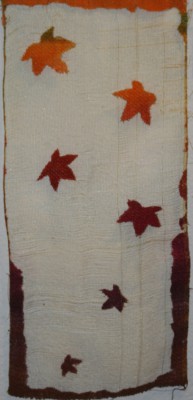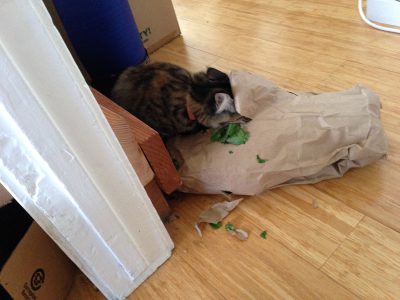Suki Russack spoke at my guild last night, and showed off her beautiful doubleweave wall hangings. On examining one closely, I saw that one layer was a densely sett, warp-faced background in heavy yarns, and the other was a very loosely sett, gauzy accent in fine yarns. The loosely sett layer was so open that the yarns had shifted into wavy lines, producing a beautiful textured effect.
Suki achieves her results by using pick-up on six shafts (she said that technically she could use four, but since the background layer is sett so densely as to be warp faced, it weaves better when spread onto four shafts + two for the accent layer). Pick-up is quite slow, and would be even slower in the fine threads that I prefer. And I don’t enjoy it, so I’m not likely to use her method.
But then something hit me: what about devoré? In my sampling for Autumn Splendor, I had produced this lovely sample:


I made this sample by weaving 20/2 tencel at 36 ends per inch, interspersed with metallic gold embroidery thread placed every fourth thread in warp and weft. I used a painted warp and a painted weft to achieve a color gradation across the entire fabric. Then I burned out the tencel over most of the piece, leaving only the mesh of gold embroidery thread.
It was gorgeous but far too delicate to show; the mesh distorted at the slightest touch. So I set it aside and went on to other things.
However, it’s occurred to me that if I combined the devoré technique with double weave, I could get some really spectacular results. Suppose I did a two-layer doubleweave, with a dark blue/black top layer with an embedded gold mesh. The bottom layer would be fiery scarlets. Then I could burn out the top layer to get a fiery red phoenix (yes, I know, I’m stuck on phoenixes – what can I say? Phoenix Rising isn’t done yet!) glittering under a wavy gold mesh against dark blue and black background. That would be pretty darn neat. If I did a stitched double weave with the stitching done in the mesh, I could stabilize it enough that it wouldn’t shift too much.
To make things even more mind-blowing, I could use triple weave to make either phoenix or background more complex. Or I could do triple weave with two burnout layers. The wonderful thing about having 40 shafts is that I can do triple weave and still have 12 shafts to play with on each layer plus four shafts for selvages! This is pure luxury.
Anyway, my head is now spinning with possibilities. I really have to get that color study warp off the loom so I can try new stuff!
Speaking of new stuff, Tigress discovered the world of leafy greens recently:

I’m not sure if she loves eating beet greens or was just helping us compost them (apparently she knows that shredding things into lots of tiny bits makes them compost faster!), but she was pretty funny to watch, either way. (Fortunately we don’t eat beet greens, we compost them, so no humans were deprived of food in the making of this photo. 🙂 )

You don’t eat beet greens?! That is the best part. Too bad I live 1000 miles away or I would love to deprive Princess of her fun.
What’s a good recipe for beet greens? They’re a little tough for a quick saute, but I haven’t figured out other ways to use them yet.
I love the greens in a salad. I roast the beets themselves, use the little leaves (and definitely watch to exclude the thick stems), and a very simple vinaigrette. A bit of goat cheese or toasted almonds are also good additions.